|
|
|
1.
|
What is most likely the | slope of the line
graphed? | 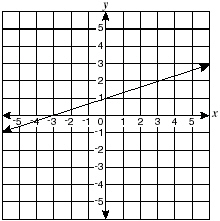 | | |
|
|
|
2.
|
What is the apparent slope of  ? 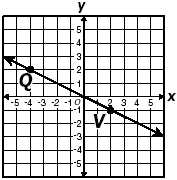
|
|
|
3.
|
Which condition will guarantee that line l is parallel to line
m? 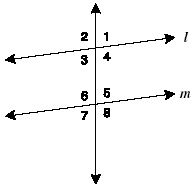 A) | Ð1 @ Ð3 | B) | Ð1 @ Ð6 | C) | Ð6 @ Ð5 | D) | Ð3 @ Ð5 |
|
|
|
4.
|
Line n intersects lines p, q, r, and s,
forming the indicated
angles.
Which two lines are parallel? | 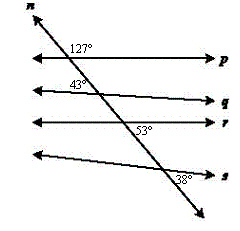 | | |
A) | p and q | B) | p and r | C) | q and
r | D) | r and s |
|
|
|
5.
|
Which will prove that line l
is parallel to line m?
| 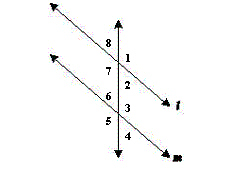 | | |
A) | Ð8 @ Ð5 | B) | Ð7 @
Ð6 | C) | Ð3 @
Ð8 | D) | Ð5 @
Ð1 |
|
|
|
6.
|
Which two points determine a line
parallel to line  ? ? | 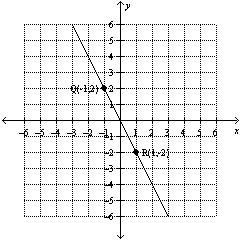 | | |
A) | (1,1) and (2,-1) | C) | (1,4) and (5,2) | B) | (-1,-1) and (-2,-3) | D) | (2,1) and
(-2,-1) |
|
|
|
7.
|
Given: m Ð1 = 107 °
Which must be true if y || z? | 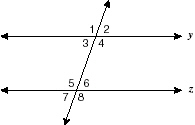 | | |
A) | mÐ8 = 97° | B) | mÐ7 = 107° | C) | mÐ6 = 83° | D) | mÐ5 = 107° |
|
|
|
8.
|
What is most likely the slope | of
the line graphed to the right? | 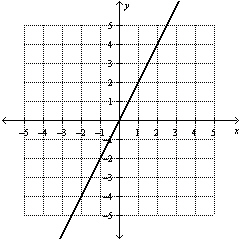 | | |
|
|
|
9.
|
Which two segments in the drawing | are
most likely parallel? | 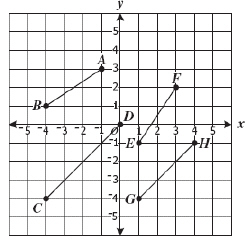 | | |
|
|
|
10.
|
In this figure, two lines are cut by a transversal. Which type of angles are
Ð1 and Ð2? 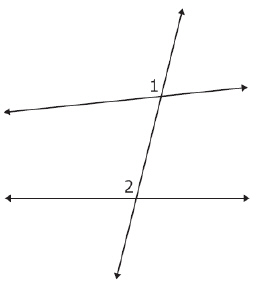 A) | Vertical Angles | C) | Alternate Interior Angles | B) | Corresponding
Angles | D) | Same-Side Interior
Angles |
|
|
|
11.
|
In this figure, transversal e
intersects lines a, b, c, and d.
Which lines must be
parallel? | 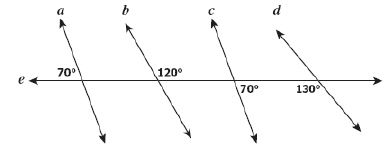 | | |
A) | a and c | B) | b and
c | C) | b and d | D) | a and d |
|
|
|
12.
|
Lines m and r are cut by a
transversal.
What value of x will show that line m is
parallel to line r ? | 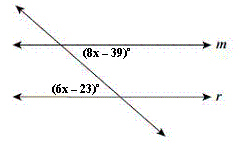 | | |
|
|
|
13.
|
For what value of x is | line l parallel to line
m in this figure? | 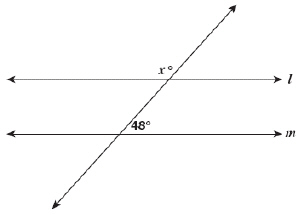 | | |
|
|
|
14.
|
This figure represents line segments painted on a
parking lot to create parking spaces.
Which equation can be used to show that these line segments are parallel? |  | | |
A) | 122 - w = x | C) | x + 122 =
180 | B) | 122 - x = w | D) | w + 122 = 180 |
|
|
|
15.
|
Victor used a decorative fencing to
enclose his deck.
Using the information on the diagram and assuming the top and bottom
are parallel, the measure of Ðx is | 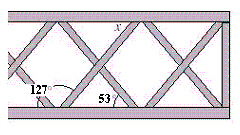 | | |
|
|
|
16.
|
Use this figure to answer the following. A) | mÐ1 = mÐ2 | C) | mÐ1 + mÐ2 = 90° | B) | mÐ3 = mÐ4 | D) | mÐ1 +
mÐ2 = mÐ3 +
mÐ4 |
|
|
|
17.
|
In the figure, lines c and d are cut by the transversal i forming the angles shown.
Ð6 and
Ð8 are |  | | |
A) | Consecutive interior angles | C) | Vertical angles | B) | Alternate interior
angles | D) | Corresponding
angles |
|
|
|
18.
|
Line t intersects lines p, q, r, and s.
Which two lines are
parallel? | 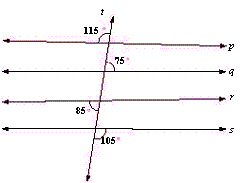 | | |
A) | Line p and line q | B) | Line p and line
r | C) | Line q and line s | D) | Line r and line
s |
|
|
|
19.
|
The measure of ÐYZV is 42 ° and the measure of ÐXYZ is 61°.
Which of these angles must measure 61° in order for  to be parallel to to be parallel to  ? ? | 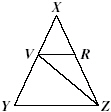 | | |
|
|
|
20.
|
The figure shows line t intersecting lines q and r.
In the figure, Ð1 and
Ð2 are |  | | |
A) | consecutive interior angles | C) | alternate exterior
angles | B) | alternate interior angles | D) | corresponding angles |
|
|
|
21.
|
Lines l and m contain the points shown.
Which of the following
points must lie on line m in order for lines l and m to be
parallel? | 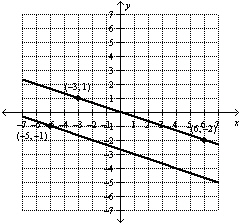 | | |
A) | (0, –4) | B) | (0, –3) | C) | (1, –3) | D) | (4,
–3) |
|
|
|
22.
|
Which statement would be sufficient | to
prove that line m is parallel to line n? | 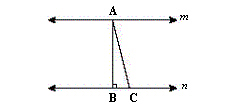 | | |
|
|
|
23.
|
In this diagram, line d cuts three lines to form the angles shown.
Which two
lines are parallel? | 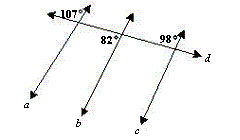 | | |
A) | a and b | C) | b and c | B) | a and
c | D) | No lines are
parallel. |
|
|
|
24.
|
Which condition will guarantee |
that line a is parallel to line b? | 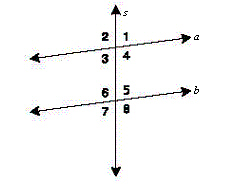 | | |
A) | Ð 3 @ Ð 1 | B) | Ð 5 @ Ð 2 | C) | Ð 1 @ Ð 2 | D) | Ð 2 @ Ð 8 |
|
|
|
25.
|
Which is most likely the | slope of the line graphed? |  | | |
|